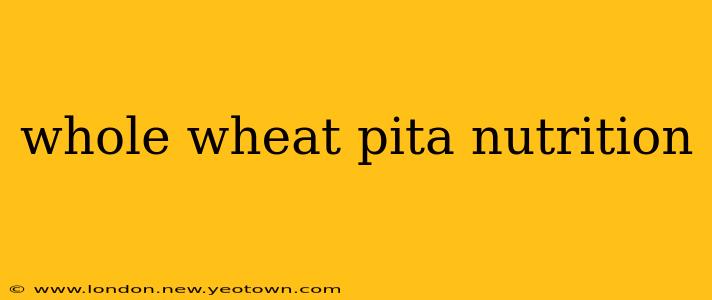The aroma of warm pita bread, slightly charred around the edges, is enough to make anyone's mouth water. But beyond its delicious taste, whole wheat pita offers a surprisingly nutritious punch. This isn't your average processed white bread; we're diving deep into the nutritional profile of this healthy flatbread and exploring why it deserves a spot in your diet. Think of this as your ultimate guide to understanding the nutritional powerhouse that is whole wheat pita bread.
What are the nutritional benefits of whole wheat pita bread?
Whole wheat pita boasts a compelling nutritional profile, packed with essential nutrients often lacking in refined grain products. Compared to its white counterpart, it shines in its fiber content, which aids digestion and keeps you feeling full for longer. This fiber also contributes to healthy cholesterol levels and helps regulate blood sugar. Beyond fiber, whole wheat pita provides a decent dose of iron, crucial for energy production and oxygen transport throughout the body. It also contributes to your daily intake of manganese, a mineral involved in bone health and metabolism.
How many calories are in a whole wheat pita?
The calorie count in a whole wheat pita can vary depending on the size and brand. Generally, a single, average-sized whole wheat pita contains between 150-200 calories. This calorie count is relatively low, especially considering the significant nutritional value it provides. It's a great source of energy for your active lifestyle, without the heavy calorie load of some other bread options.
Is whole wheat pita bread good for weight loss?
The high fiber content in whole wheat pita makes it a potentially valuable asset in a weight loss journey. Fiber promotes satiety, helping you feel full and satisfied after eating, which can curb overeating and contribute to weight management. However, it's essential to remember that pita bread, even the whole wheat variety, should be consumed as part of a balanced diet and healthy lifestyle. It's not a magic weight-loss bullet, but a nutritious component of a well-rounded approach.
How does whole wheat pita compare to other breads?
Compared to white pita or other refined grain breads, whole wheat pita emerges as the clear winner in terms of nutritional value. The whole grains retain the bran and germ, preserving the fiber, vitamins, and minerals lost during the refining process. This results in a far more nutrient-dense bread option, offering significant health advantages. While other whole grain breads offer similar benefits, the portability and versatility of pita bread make it a convenient and delicious choice.
What are the potential downsides of eating whole wheat pita?
While largely beneficial, whole wheat pita isn't without potential drawbacks. Individuals with gluten sensitivity or celiac disease should avoid it, as it contains gluten. Additionally, some people might experience digestive discomfort if they consume large quantities of fiber without gradually increasing their intake. Starting with a smaller portion and increasing gradually can help mitigate this issue.
Is whole wheat pita healthy?
In conclusion, yes! Whole wheat pita is a healthy choice when incorporated into a balanced diet. Its high fiber content, essential nutrients, and relative low calorie count make it a nutritional powerhouse. It's a versatile flatbread that can be enjoyed in various ways, making it a convenient and delicious addition to a healthy lifestyle. Remember, moderation is key. Enjoy it as part of a balanced meal plan for optimal health benefits.

